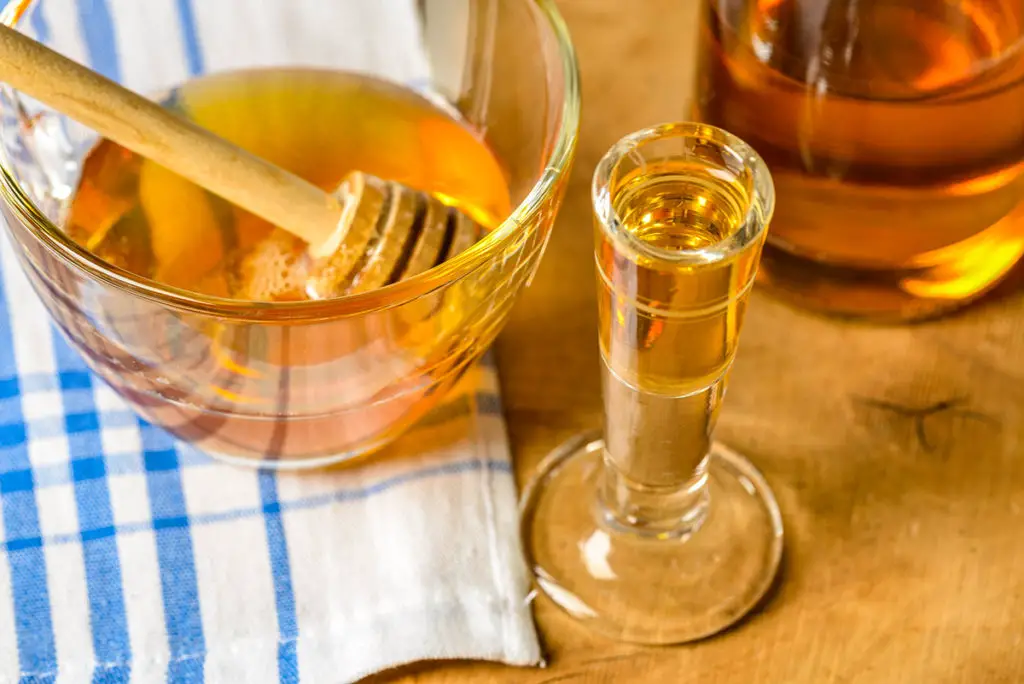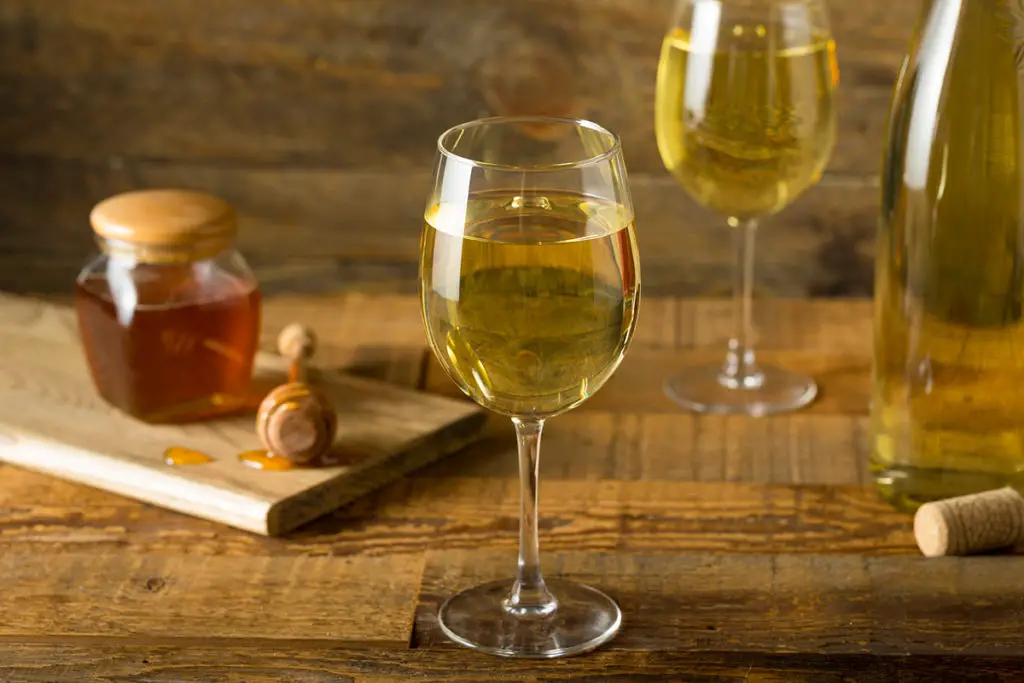Mead has been enjoyed by ancient cultures in Europe, Africa, and Asia, long before the Vikings began brewing it. Even today, mead is popular in some cultures, and a version of the honey wine is the national drink of Ethiopia. Yet many Americans have no idea what it tastes like nor how to drink it.
Mead tastes sweet or dry, depending on the honey and ingredients added by the brewer. It has more alcohol than beer and is equivalent to wine, but mead can have alcohol levels between 3% and 20% or even higher. When pairing mead with foods, the guidelines are similar to wine and food pairings.
Whether you’re interested in trying mead at a medieval tournament or historical re-enactment or trying some at a local restaurant or mead brewery, this guide will prepare you. If you want to know what mead tastes like, how to pair it, and the different types of mead, you’re in the right place.
What Does Mead Taste Like?
Since mead is made from honey, most people expect mead to taste sweet. However, asking what mead tastes like is asking what bread tastes like, as there are so many styles of mead that you can expect everything from sweet to dry.
No matter the type of mead, expect it to taste like honey. The flavor of mead starts with the honey used, but there are many different kinds of honey. For example, mead made with tupelo honey will taste different from clover honey.
In addition, the mead’s flavor will change based on the additional ingredients and its alcohol and sugar level. For example, a dry mead will have higher alcohol content, while a mead with cider added to the honey will taste different from one with maple syrup.
To better understand the differences in mead’s taste, you need to know more about the different types of mead.

BEER DROP: Boxes of beer from Award-winning microbreweries → Join The Club
The Various Types of Mead Explained
Pairing mead and food, or simply enjoying the mead, is complicated because, contrary to what you might think, there are many different types of mead. Meads can be sweet but also dry, light, or dark.
They can be made solely from honey, but a brewer can add other fruit to the brew. Mead alcohol content varies, and you can even find carbonated meads.
Meads start with three ingredients:
- Honey
- Water
- Yeast
These traditional meads can take on different flavors because of the honey and yeast combinations. For example, honey harvested from bees that feed on orange-blossoms tastes different than honey from blueberry-loving bees.
However, mead varieties don’t stop there. For example, a bochet is a mead made from caramelized honey, and bochetomels contain toasted honey and fruits.
This leads us to melomels, which are meads that contain ingredients beyond the basics. Bochotomels would be classified as a type of melomel, while black Mead, which is made with black currants, is another melomel.
Metheglins are meads with added spices, such as cinnamon, nutmeg, and other botanicals. For many years, metheglins were used for medicinal purposes. Metheglins served warm is called mulled meads, and they’re often served around the holidays.
Pyments are one of several meads made with additional fruits. Grapes are added to Pyments, while a cyser contains apple juice. Since most alcohol comes from honey, they’re still considered meads, not wines or ciders.
Meads can be flavored with chili peppers (capsicumel), maple syrup (acerglyn), and yes, coffee. Mead is even combined with beer or malt or hops to make Braggot.
For as long as there has been mead, mead brewers have experimented with creating innovative varieties.
What Should Mead Be Paired With?
The rules for pairing mead are relatively straightforward at first. Dry meads are served with dinner, sweet meads are served with dessert, and sparkling meads are served on their own. But as you learn more, the rules become more complex.
Beef is simple. The rule of thumb is dark with dark, so if your meal is dark and heavy, you’ll want a darker mead that can stand up to the flavor profile.
However, what about a stew? Or how about chili?
Serve dark fruit mead melomel for mulled meads with pork chops, BBQ, stews, and savory dishes. Their dark, earthy flavors complement the darker, heavier meads, just as similar foods complement fruity red wines. If you have game meat like rabbit pheasant, you might want to consider a fruity mead on the drier side.
Because the qualities of a dry mead can be similar to those of wine, it pairs well with shellfish, white meats, and lighter meals. In addition, serve a dry mead with sampler plates with a range of items such as thinly sliced meats, nuts, and fruits.
Spicy dishes pair well with fruity meads because their sweetness balances the zing.
For the most part, sparkling mead should be savored on its own, as a refresher on hot summer days, a celebratory sip, or to cleanse the palate between courses.
How Should Mead Be Served
Since mead is closer to wine than beer, you can follow similar guidelines to serving wines. However, the ideal serving temperature should be determined by the type of food being served and the time of the year.

The Ideal Temperature for Serving Mead
Light mead is especially popular in the summertime. You should refrigerate it to be a refreshing reprieve from the heat. However, the mead shouldn’t be iced, or you won’t be able to taste the full range of flavors.
The reason mead shouldn’t be too cold is due to how scents and flavors are released from a drink, and mead that’s too cold becomes “closed.” Closed drinks are too stable and won’t release the gases required to bring out the full range of the beverage’s flavors.
Treat your mead like you would a red wine and serve it at cellar temperature which is about 52 – 70°F (11.11 – 21.11°C). Lighter meads can be slightly cooled to the same temperature as a full-bodied white wine.
A mulled mead can be served hot but not brought to a boil. Try to keep it from going above 140°F (60°C).
The Best Container for Serving Mead
For mead drinking, stemmed red wine glasses are usually the best option. The wider bowl lets the mead’s aroma fully develop. However, some drinkers prefer brandy snifters, so experiment to see what feels right for you.
Ideally, drink from a clear glass or crystal. The color of your mead should be a significant part of your drinking experience.
Meads come in a range of beautiful color tones, from pale gold to deep amber, and drinking from glass lets you enjoy the drink’s hues.
Alcohol Content In Mead
If you drink a glass of mead thinking it’ll have a similar alcohol effect, you’ll be surprised by how much alcohol mead can have. Although some varieties have alcohol levels on par with beers and wines, most meads are more potent than wine.
A drink’s alcoholic content calculates alcohol by volume (ABV). It’s defined as the volume of alcohol as a percentage of the total volume of the drink. For example, beer has an average ABV of 4.5%, wine has an 11.6% ABV, and liquor’s alcohol by volume is 37%.
The alcohol content of a drink varies because of the fermentation process.
In fermentation, yeast converts sugars into alcohol, and the amount of alcohol present in the final product results from two factors, which include the amount of yeast and the length of the fermentation process.
Mead’s alcohol content varies from 3% to 20%, with standard meads ranging from 7% to 14% alcohol by volume. The third category of meads—sack meads—can reach 20%, while “session” meads can be as low as 3% alcohol.
Even though standard meads have a higher percentage of alcohol than beer and are on par with wines, the percentage of alcohol is only part of the story. Serving size is the other.
The serving size for both mead and wine is 5 oz (147.87 ml), so a glass of mead will give you a similar buzz to wine assuming that you pour 5 oz (147.87 ml), or half a standard wine glass. A 12 oz (354.88 ml) serving of beer has 5% alcohol.
So 2 to 3 bottles of beer are equivalent to one glass of mead. AS you can see, it doesn’t take much mead to give you a buzz.
Can Mead Go Bad?
Mead can go bad, but because of its high alcohol content, mead will last a long time before going bad if the bottle is stored unopened. However, once opened, how long it’ll last depends on the type of mead.
Classic meads will last five or more years if not opened, while lighter meads should be consumed within a year. Once the bottles are opened, most breweries recommend you drink classic meads within 8 months and lighter meads within a couple of weeks.
Store your opened mead in a dark, dry place. The ideal temperature for storing mead is room temperature.
Avoid storing mead in locations with excessive temperature changes. Temperature swings and sunlight oxidation can cause mead to skunk, just like it does with wines and beers. If you intend to invest in expensive meads, consider looking into more stable storage than the back of a cabinet.
Recommended reading: How To Serve & Drink Mead The Right Way (Complete Guide)
Bottom Line
Mead was known as ambrosia or nectar by the ancient Greeks, and it was thought to be “the drink of the gods,” dropped from the heavens as a dew before being collected by bees. You don’t have to believe that nectar was dropped from the heavens or participate in a Viking re-enactment to enjoy this heavenly beverage.
